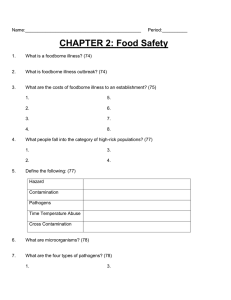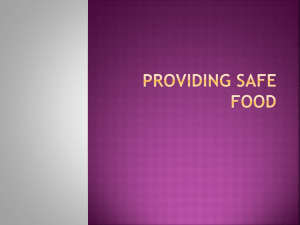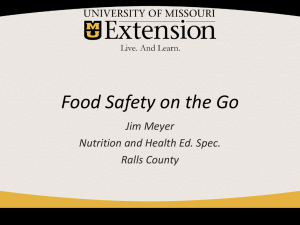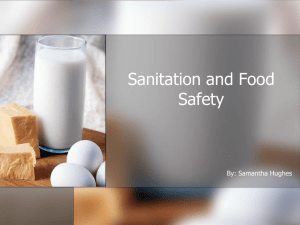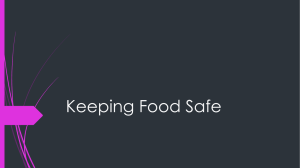World Health Organization Introduction
advertisement
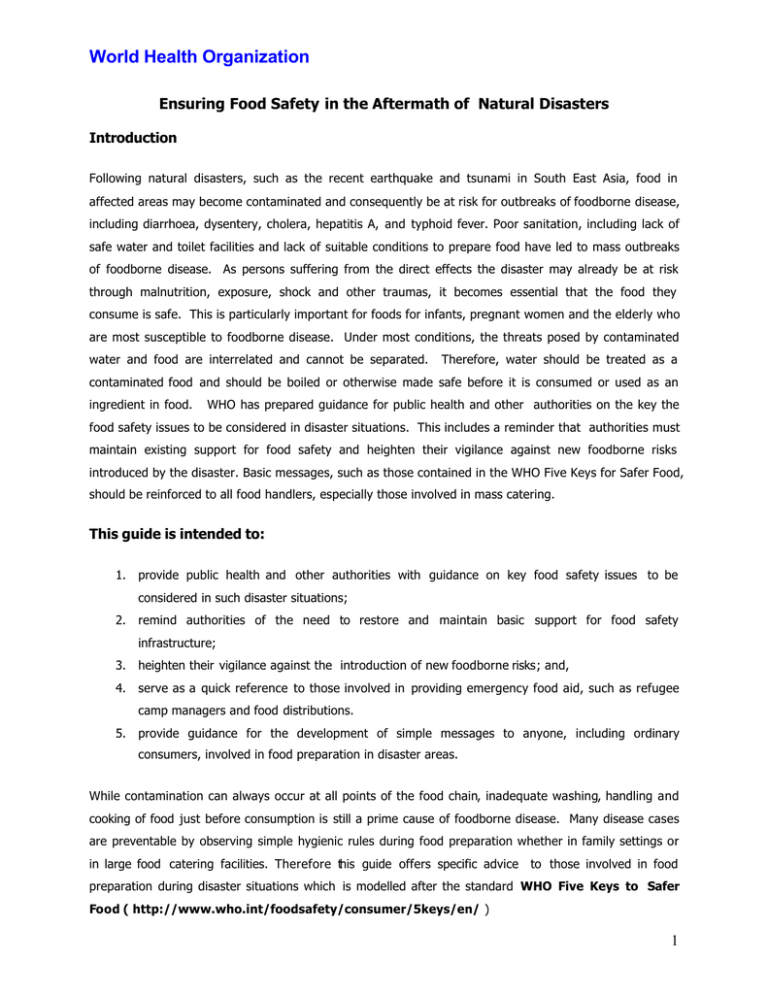
World Health Organization Ensuring Food Safety in the Aftermath of Natural Disasters Introduction Following natural disasters, such as the recent earthquake and tsunami in South East Asia, food in affected areas may become contaminated and consequently be at risk for outbreaks of foodborne disease, including diarrhoea, dysentery, cholera, hepatitis A, and typhoid fever. Poor sanitation, including lack of safe water and toilet facilities and lack of suitable conditions to prepare food have led to mass outbreaks of foodborne disease. As persons suffering from the direct effects the disaster may already be at risk through malnutrition, exposure, shock and other traumas, it becomes essential that the food they consume is safe. This is particularly important for foods for infants, pregnant women and the elderly who are most susceptible to foodborne disease. Under most conditions, the threats posed by contaminated water and food are interrelated and cannot be separated. Therefore, water should be treated as a contaminated food and should be boiled or otherwise made safe before it is consumed or used as an ingredient in food. WHO has prepared guidance for public health and other authorities on the key the food safety issues to be considered in disaster situations. This includes a reminder that authorities must maintain existing support for food safety and heighten their vigilance against new foodborne risks introduced by the disaster. Basic messages, such as those contained in the WHO Five Keys for Safer Food, should be reinforced to all food handlers, especially those involved in mass catering. This guide is intended to: 1. provide public health and other authorities with guidance on key food safety issues to be considered in such disaster situations; 2. remind authorities of the need to restore and maintain basic support for food safety infrastructure; 3. heighten their vigilance against the introduction of new foodborne risks; and, 4. serve as a quick reference to those involved in providing emergency food aid, such as refugee camp managers and food distributions. 5. provide guidance for the development of simple messages to anyone, including ordinary consumers, involved in food preparation in disaster areas. While contamination can always occur at all points of the food chain, inadequate washing, handling and cooking of food just before consumption is still a prime cause of foodborne disease. Many disease cases are preventable by observing simple hygienic rules during food preparation whether in family settings or in large food catering facilities. Therefore this guide offers specific advice to those involved in food preparation during disaster situations which is modelled after the standard WHO Five Keys to Safer Food ( http://www.who.int/foodsafety/consumer/5keys/en/ ) 1 World Health Organization 1. Preventive food safety measures in the aftermath of natural disasters During and following natural disasters, particularly floods and tsunamis, food may become contaminated by surface water that has itself been contaminated by pathogenic bacteria from sewage and wastewaters from sewer systems, septic tanks, and latrines as well as from farms and farm animal. The following issues should be investigated: • The protection of food requires attention along the food chain, including the primary production sectors.. • While much of the normal agricultural production may be adversely affected by flooding associated with a tsunami, there may be areas where food can still beharvested or where food has been stored safely post harvesting. • If agricultural produce is harvested from an area affected with flooding it may be contaminated with microorganisms (from raw sewage or decaying organisms) and chemicals in the flood waters. While it is possible to reduce the potential hazard associated microorganisms by thoroughly cooking the produce, such actions may not remove chemical hazards. Therefore only harvest food from affected areas where it is necessary and where you can be confident that chemical contamination has not occurred. Also ensure the product is properly identified as being harvested from an affected area. • Similarly agricultural produce that was stored in the affected areas at the time of the disaster may also be affected by the flood waters. Such food should betreated as with food harvested from affected areas. • If crop fields have been contaminated by human excreta, following floods or damage to sewerage systems, an assessment should be carried out rapidly to assess the contamination of crops and to establish measures, such as delayed harvesting and thorough washing and cooking, to reduce the risk of transmitting faecal pathogens. • Foods that have not been affected should be protected against exposure to other sources of contamination and not kept under conditions in which bacterial growth may occur. Safe and hygienic warehouse management must be observed: • Storage structures should have good roofs and ventilation. Products should be kept at away from walls and off the floor. Pallets, boards, heavy branches, bricks, or plastic bags or sheets should be placed underneath them. Bags should be piled two-by-two cross-wise to permit ventilation. • Spilled food should be swept up and disposed of promptly to discourage rats. • Fuel, pesticides, bleach and other chemical stocks should never be stored together with food. • If spray operations for pest control are needed, they should be carried out by qualified technical 2 World Health Organization staff, under the close supervision of the national authority (M inistry of Health / Ministry of Agriculture). Wearing of protective gear to reduce exposure of the operators to toxic chemicals is essential. Safe food handling during food distribution and preparation must be assured During emergency response operations, large-scale distribution of imported or locally-purchased food items as well as mass preparation of cooked food frequently occur . In this context special attention must be brought to the following: Ø All foods used infood distribution and mass feeding programmes must be fit for human consumption (as well as being nutritionally and culturally appropriate) The quality and safety of all items should be controlled before importation or local purchase and any unfit items be rejected. q Stocks should be regularly inspected and any suspect stocks should be separated from other stocks and samples be sent to a suitable laboratory for analysis; in the meantime they should not be used. q Kitchen supervisors, cooks and ancillary personnel should be trained in personal hygiene and the principles of safe food preparation (See Annex). q Kitchen supervisors should be trained to be able to recognize potential hazards and apply appropriate food safety measures; the personal hygiene of personnel involved in food preparation should be monitored. q Employees and volunteers preparing food should not be suffering from an illness with any of the following symptoms: jaundice, diarrhoea, vomiting, fever, sore throat (with fever), visibly infected skin lesions (boils, cuts, etc.), or discharge from the ears, eyes or nose. q Cleaners should be employed to keep the kitchen and surrounding areas clean; they should be properly trained and their work supervised and there must be adequate facilities for waste disposal. q Water and soap must be provided for personal cleanliness, and detergent for cleaning utensils and surfaces which should also be sanitized with boiling water or a sanitizing agent, e.g. bleach solution. q Foods should be stored in containers that will prevent contamination by rodents, insects, or other animals q Hot and/or cold holding of food may have to be improvised. 3 World Health Organization 2. Consumer education and information q In many cases, consumers will be preparing food under conditions that are more primitive than normal, due to lack of water supply and electricity. This is especially the case for homeless people who have no facilities or equipment for food preparation. In all cases however, consumers should be warned to take special care regarding food safety from the procurement of raw materials and water, through handling and preparation to final consumption. In this regard, WHO's Five Keys to Safer Food have been adapted to be more relevant to the current tsunami disaster conditions in South East Asia. This version is presented in the Annex. This version could provide guidance for the preparation of local versions aimed at specific target populations. It is also recognized that this version may need other adaptations to meet the needs of the local situation. For example, when food is likely to be contaminated by chemicals from warehouses, chemical plants, and other sources, people should be advised to avoid those types of food. General information and advice should also be provided to the population on the risks of foodborne diseases to remind the population that: q dangerous communicable disease outbreaks in disaster regions has the potential to claim as many lives as the disaster itself, and that safe water and food are the two main factors to prevent such outbreaks. q key behaviours of safe food handling and preparation are the most important measures they can take to protect their families and themselves q key behaviours of hygiene and sanitation are the most important measures they can take to protect the society from disease outbreaks. 4 World Health Organization 3. Inspecting and salvaging food • Food industries, slaughterhouses, markets and catering establishments should be inspected to ensure their safe operation. Particularly attention should be given to those handling perishable products, such as milk. Steps should be taken so that foods that have been adversely affected are not marketed. • When salvaged foods are fit for consumption and sold, they should be labelled accordingly and consumers should be clearly informed of measures they need to take to render them safe. • In areas that have been flooded, whatever intact foods remain should be moved to a dry place, preferably away from the walls and off the floor. • Any food stocks found to be unfit for human consumption must be disposed of -- used for animal feed, industrial purposes or destroyed depending on the assessment of food safety authorities. Condemned food may be marked with a harmless dye, such as gentian violet to ensure that the item will not be used for human consumption; • When salvaged foods are deemed fit for consumption and sold, they should be labelled accordingly. If necessary, consumers should be clearly informed of measures they need to take to render them safe. Assessing and using salvaged pre-packaged food • Discard canned foods with broken seams, dents, or leaks; and jars with cracks. • Undamaged canned goods and commercial glass jars of food are likely to be safe. However, if possible you should sanitize the containers before opening them for use. To do this, wash the jars and cans thoroughly. This may result in loss of labels so mark contents on can or jar lid with indelible ink before washing. Finally, immerse containers for 15 minutes in a solution of 2 teaspoons of chlorine bleach per quart of room temperature water. Air dry before opening. Foods that are exposed to chemicals should be thrown away. The chemicals generally cannot be washed off the food. This includes foods stored in permeable containers like cardboard as well as screw-top jars and bottles which are difficult to clean. Assessing and using salvaged refrigerated food • Inspect refrigerators to determine if they have been affected by the lack of electricity or flood waters. Where refrigerators and cold food have not been directly affected, they may be a suitable source of safe food. • Where power is not available, try to use refrigerated food before it is held in the danger zone (5- 5 World Health Organization 60oC) for more than two hours, especially meat, fish, poultry and milk. • To avoidthe loss of meat, fish, poultry and milk, these may be placed in a freezer immediately if they have not reached the danger zone. They may also be cooked and frozen if they are to be kept longer. • Some foods normally stored in the refrigerator can be kept in the danger zone for longer than others. Under emergency conditions it is possible that foods such as butter, margarine, fresh fruits and vegetables, open jars of concentrates and sauces and hard and processed cheeses can be kept and used for a longer period but they should definitely be discarded if they show signs of spoilage (odour, texture, gassiness, mouldiness). • To prevent warm air from entering the refrigerator, open it only when necessary. Assessing and using salvaged dry stores of food • Check all food for physical hazards (such as glass) that may have been introduced during the earthquake. • The likelihood of mould growth on stored dried vegetables, fruits and cereals is greater in a humid environment and where food has become wet. Mould growth can be associated with chemical toxins. • Intact food should be moved to a dry place, away from the walls and off the floor! Bags must not lie directly on the floor – pallets, boards, heavy branches, bricks, or plastic bags or sheets should be placed underneath them. Bags should be piled two-by-two cross-wise to permit ventilation. • Wet bags should be allowed to dry in the sun before storing them. • Damaged bags should be rebagged and stored apart from undamaged ones. A reserve of goodquality empty bags should be kept for this purpose. • Spilled food should be swept up and disposed of promptly to discourage rats. 6 World Health Organization 4. Provision of Food After a Natural Disaster • After a natural disaster, as soon as families have reestablished their capacity to cook, any food they may be given is usually distributed in dry form for them to prepare and consume in their homes or temporary shelters. People may not always be familiar with all kinds of dry foods. When given, they should be shown how to prepare dry foods. • In addition to safe water for food preparation, a means of washing hands and utensils will be needed. • A shortage of fuel for cooking may also be a major constraint, and this may need to be supplied to ensure adequate cooking and reheating of cooked food. • In some cases, as an alternative to mass feeding, it may be possible to help households by providing shelf-stable rations that do not need cooking or by setting up temporary shared neighborhood kitchens where people can prepare food for their own families or in groups. 7 World Health Organization 5. Response to an outbreak of foodborne disease It is vital to detect food borne diseases as early as possible. Indications of a foodborne disease outbreak that should trigger an investigation include: • increase in diseased persons visiting clinics • reports from health workers of foodborne disease symptoms, • reports from pharmacists of an unusual demand for anti-diarrhoeal agents, anti-emetics or other medication for gastrointestinal problems, e.g. antibiotics • an upsurge in inexplicable customers’ complaints to a food supplier, food industry • reports of unusual death • unusual absenteeism from schools and the workplace, especially in large industries Detection may also be through an existing communicable disease surveillance systems if the cluster is large enough (and there is no separate food-borne disease surveillance system). Investigation of and response to a suspected food safety emergency involves: • timely treatment of exposed people • removal (recall) of the contaminated food from circulation This should be coordinated by the national food safety agency in collaboration with the food industry and other food providers. • rapid identification of the causative agent and the suspected foods by patient interviews and by appropriate diagnostic laboratory testing • epidemiological investigation to identify the causative agent, the responsible food and the manner of contamination including: collection, transport and processing of samples; collation of information about sources of contamination and coordination with law enforcement, food safety regulatory authorities, industry, emergency medical response agencies, and (when imported food may be involved) quarantine and customs agencies (swift communication among all these entities is essential) • timely provision of information to the public on food-related risks and the actions they should take to minimize those risks; the information must be conveyed in a manner that is culturally appropriate and does not cause unnecessary anxiety The effectiveness of response depends to a great extent on preparedness including a) the capacities for investigation and verification, and b) coordination between relevant government and other agencies that contribute to managing the public health consequences. 8 World Health Organization Annex: “5 Keys for Safer Food - in regions hit by disasters” The information provided is intended to present the five core food safety messages as they could be presented to people involved in food preparation in areas affected by the Tsunami disaster 26.12.04. While it should be realized that some of the instructions mentioned here will not be practicable in all situations, attempts to adhere as best possible to the general keys will contribute to disease prevention. The general 5 keys, including translation into local languages can be found at www.who.int/foodsafety 9 World Health Organization Food safety is essential for disease prevention In the aftermath of natural disasters KEY 1: KEEP CLEAN - (prevent the growth and spread of dangerous microorganisms) • Wash your hands with soap and water (or other means such as wood ashes, aloe extract or dilute bleach) after toilet visits, before and after handling raw food and before eating • Avoid preparing food directly in surroundings flooded with water • Wash/sanitize all surfaces and equipment - including hands - used for food preparation • Protect kitchen areas and food from insects, pests and other animals • Keep persons with diarrhoea - or other symptoms of disease - away from food preparation areas • Keep faecal material away from food-preparation areas (separate kitchen and toilet areas) • Avoid eating food raw if it may have been flooded, e.g. vegetables and fruits - see also Key 5. Why? Dangerous microorganisms are widely found in the gut of animals and people and therefore also in water and soil in areas with poor sanitation as well as in areas with flooding. These microorganisms can be transferred to food and can, even in low numbers, cause foodborne disease. 10 World Health Organization Food safety is essential for disease prevention In the aftermath of natural disasters KEY 2: SEPARATE RAW AND COOKED FOOD (prevent the transfer of microorganisms) • Separate raw meat, poultry and seafood from ready-to-eat foods • Separate animal slaughtering and food preparation areas • Treat utensils and equipment used for raw foods as contaminated - wash and sanitize before other use • Separately store raw (uncooked) and prepared foods • Avoid contamination with unsafe water: ensure water used in food preparation is potable or boiled • Peel fresh fruits before eating Why? Raw food, especially meat, poultry and seafood and their fluids may contain dangerous microorganisms that can be transferred onto other foods during food preparation and storage. Prevent the transfer of microorganisms by keeping raw and prepared food separate. Remember that cooked food can become contaminated through the slightest contact with raw food, unsafe water or even with surfaces where raw food has been kept. 11 World Health Organization Food safety is essential for disease prevention In the aftermath of natural disasters KEY 3: COOK THOROUGHLY (kill dangerous microorganisms) • Cook food thoroughly, especially meat, poultry, eggs and seafood until it is steaming hot throughout • For cooked meat and poultry to be safe their juices must run clear and no parts of the meat should be red or pink • Bring foods like soups and stews to boiling and continue to boil for at least 15 minutes to make sure all parts of the food has reached at least 70°C. • While cooked food should generally be eaten immediately, if necessary thoroughly reheat cooked food until it is steaming hot throughout. Why? Proper cooking kills dangerous microorganisms. The most important microorganisms are killed very quickly above 70°C, but some can survive up to 100°C for minutes. Therefore all cooked food should generally reach boiling temperatures and be cooked at such temperatures for extended periods. Remember that big pieces of meat will only heat up slowly. It is also important to remember that in emergency situations with the potential for significant contamination levels in food, the food should be cooked for longer periods. 12 World Health Organization Food safety is essential for disease prevention In the aftermath of natural disasters KEY 4: KEEP FOOD AT SAFE TEMPERATURES (prevent growth of microorganisms) • Eat cooked food immediately and do not leave cooked food at room temperature longer than 2 hours • Keep cooked food steaming hot (more than 60°C) prior to serving • Cooked and perishable food that cannot be kept refrigerated (below 5°C) should be discarded Why? Microorganisms multiply quickly if food is stored at ambient temperature - the multiplication is quicker the higher the temperature - and quickest at around 30-40°C. The higher the number of microorganisms in the food the higher the risk for foodborne disease. In general discard food that cannot be eaten within 2 hours - if necessary, food should be kept really hot or really cold. Most microorganisms cannot multiply in food which is too hot or too cold (higher than 60°C or lower than 5°C) 13 World Health Organization Food safety is essential for disease prevention In the aftermath of natural disasters KEY 5: USE SAFE WATER AND RAW MATERIALS (prevent contamination) • Use safe water or treat it to make it safe - e.g. through boiling or treatment with chlorine tablets • Wash or preferably cook vegetables and peel fruits that are eaten raw • Use clean containers to collect and store water and clean utensils to dispense stored water • Select fresh and wholesome foods - discard damaged, spoiled or mouldy food • Breast-feed infants and young children at least up to the age of 6 months Why? Raw materials, including water, may be contaminated with microorganisms and dangerous chemicals, especially in areas hit by flooding. Likewise the risk of vegetables and fruits being contaminated with water containing sewage is high under a flooding disaster Toxic chemicals may be formed in spoiled and mouldy foods. Safe water may be seriously contaminated with dangerous microorganisms through direct contact with hands or unclean surfaces. Breast-feeding protects infants against diarrhoea through its antiinfective properties, and minimizes their exposure to dangerous foodborne microorganisms. 14
